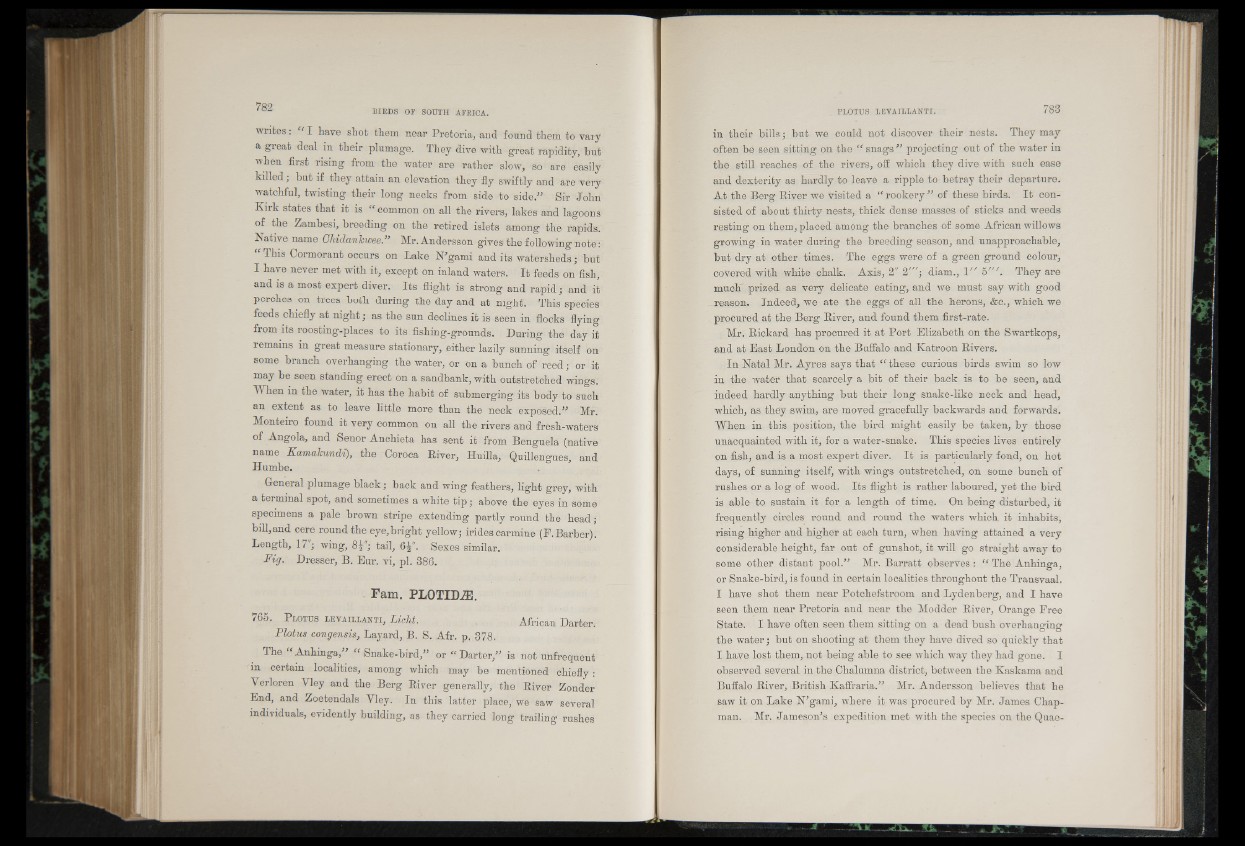
writes: “ I have shot them near Pretoria, and found them to vary
a great deal in their plumage. They dive with great rapidity, but
when first rising from the water are rather slow, so are easily
killed; but if they attain an elevation they fly swiftly and are very
watchful, twisting their long necks from side to side.” Sir John
Kirk states that it is “ common on all the rivers, lakes and lagoons
of the Zambesi, breeding on the retired islets among the rapids.
Native name Ohidankwee.” Mr.Andersson gives the following note:
This Cormorant occurs on Lake N’gami and its watersheds; but
I have never met with it, except on inland waters. It feeds on fish,
and is a most expert diver. Its flight is strong and rapid; and it
perches on trees both during the day and at night. This species
feeds chiefly at night; as the sun declines it is seen in flocks flying
from its roosting-places to its fishing-grounds. During the day it
remains m great measure stationary, either lazily sunning itself on
some branch overhanging the water, or on a bunch of reed; or it
may be seen standing erect on a sandbank, with outstretched wings.
When in the water, it has the habit of submerging its body to such
an extent as to leave little more than the neck ex posed. ” Mr.
Monteiro found it very common on all the rivers and fresh-waters
of Angola, and Senor Anchieta has sent it from Benguela (native
name Kamakundi), the Coroca Eiver, Huilla, Quillenfraes and
Humbe.
General plumage black; back and wing feathers, light grey, with
a terminal spot, and sometimes a white tip; above the eyes in some
specimens a pale brown stripe extending partly round the head;
bill,and cere round the eye,bright yellow; irides carmine (F.Barber).
Length, 17 ; wing, 8^ ; tail, 65". Sexes similar.
Fig. Dresser, B. Bur. vi, pi. 386.
Fam. PLOTIDiE.
765. P lotus lev a il la n t i, Licht. African Darter.
Plotus congensis, Layard, B. S. Afr. p. 378.
The “ Anhinga,” “ Snake-bird,” or “ Darter,” is not unfrequent
in certain localities, among which may be mentioned chiefly:
Yerloren Vley and the Berg River generally, the River Zonder
End, and Zoetendals Yley. In this latter place, we saw several
individuals, evidently building, as they carried long trailing rushes
in their bills; but we could not discover their nests. They may
often be seen sitting on the “ snags ” projecting out of the water in
the still reaches of the rivers, off which they dive with such ease
and dexterity as hardly to leave a ripple to betray their departure.
At the Berg River we visited a “ rookery” of these birds. I t consisted
of about thirty nests, thick dense masses of sticks and weeds
resting on them, placed among the branches of some African willows
growing in water during the breeding season, and unapproachable,
but dry at other times. The eggs were of a green ground colour,
covered with white chalk. Axis, 2" 2"'; diam., V 5///. They are
much' prized as very delicate eating, and we must say with good
reason. Indeed, we ate the eggs of all the herons, &c., which we
procured at the Berg River, and found them first-rate.
Mr. Rickard has procured it at Port Elizabeth on the Swartkops,
and at East London on the Buffalo and Katroon Rivers.
In Natal Mr. Ayres says that “ these curious birds swim so low
in the water that scarcely a bit of their back is to be seen, and
indeed hardly anything but their long snake-like neck and head,
which, as they swim, are moved gracefully backwards and forwards.
When in this position, the bird might easily be taken, by those
unacquainted with it, for a water-snake. This species lives entirely
on fish, and is a most expert diver. It is particularly fond, on hot
days, of sunning itself, with wings outstretched, on some bunch of
rushes or a log of wood. Its flight is rather laboured, yet the bird
is able to sustain it for a length of time. On being disturbed, it
frequently circles round and round the waters which, it inhabits,
rising higher and higher at each turn, when having attained a very
considerable height, far out of gunshot, it will go straight away to
some other distant pool.” Mr. Barratt observes : “ The Anhinga,
or Snake-bird, is found in certain localities throughout the Transvaal.
I have shot them near Potchefstroom and Lydenberg, and I have
seen them near Pretoria and near the Modder River, Orange Free
State. I have often seen them sitting on a dead bush overhanging
the water; but on shooting at them they have dived so quickly that
I have lost them, not being able to see which way they had gone. I
observed several in the Chalumna district, between the Kaskama and
Buffalo River, British Kaffraria.” Mr. Andersson believes that he
saw it on Lake N’gami, where it was procured by Mr. James Chapman.
Mr. Jameson’s expedition met with the species on the Quae